Economics Assignment: Business Decisions and Market Structures
VerifiedAdded on 2022/12/22
|13
|2972
|43
Report
AI Summary
This economics assignment comprehensively analyzes various economic concepts. Section A focuses on business decision-making, including completing cost tables (total, average, marginal, fixed, and variable costs), drawing and analyzing AC, MC, AFC, and AVC curves, and examining different market structures (monopolistic competition, oligopoly, and monopoly) alongside their characteristics. Section B explores the role of government in markets, specifically government intervention through free tertiary education initiatives and their impact, distinguishing between positive externalities and public/private goods, and analyzing market failures. The assignment also touches on efficiency and equity in resource distribution and a comparative analysis of Air New Zealand and Jetstar, highlighting comparative advantages.
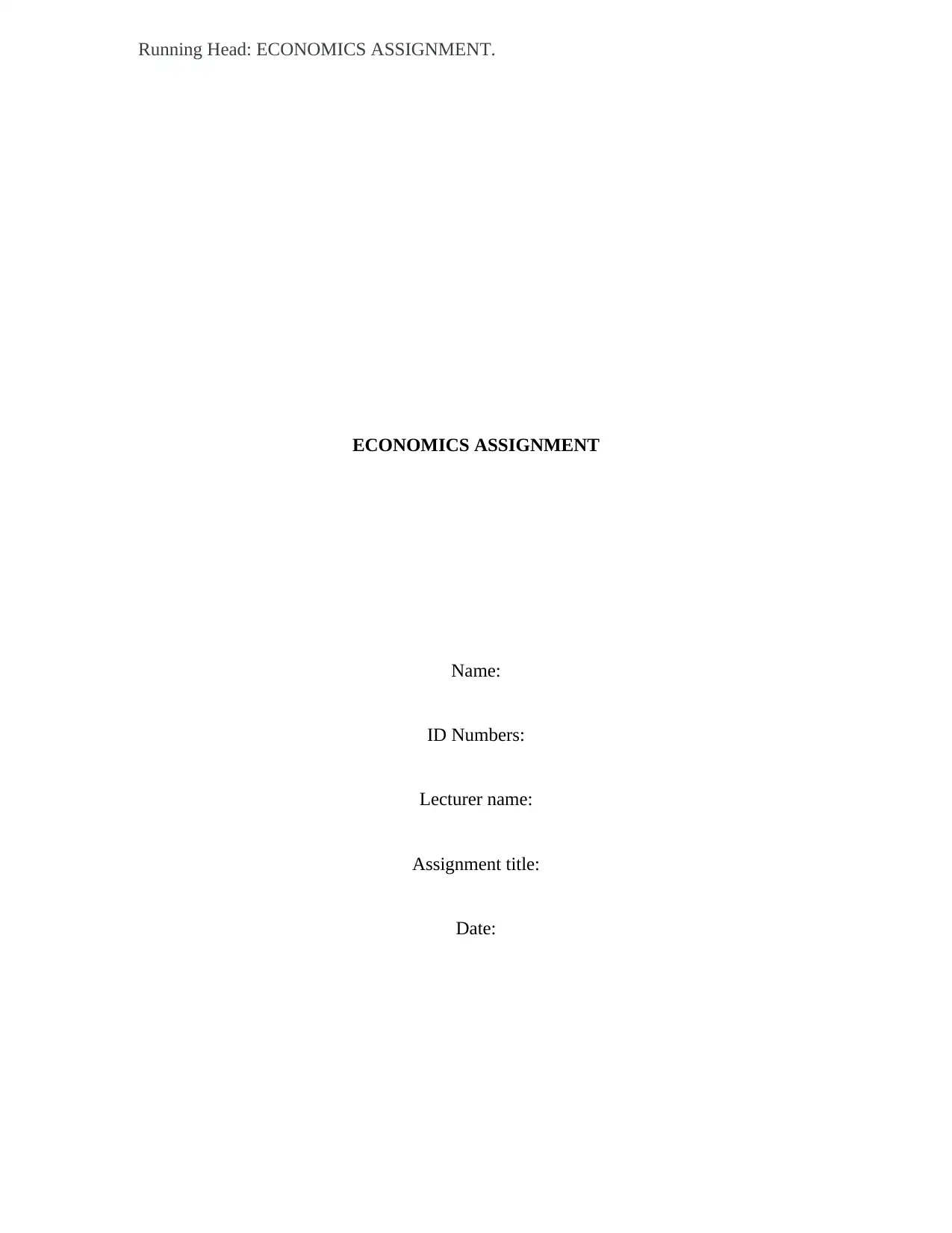
Running Head: ECONOMICS ASSIGNMENT.
ECONOMICS ASSIGNMENT
Name:
ID Numbers:
Lecturer name:
Assignment title:
Date:
ECONOMICS ASSIGNMENT
Name:
ID Numbers:
Lecturer name:
Assignment title:
Date:
Paraphrase This Document
Need a fresh take? Get an instant paraphrase of this document with our AI Paraphraser
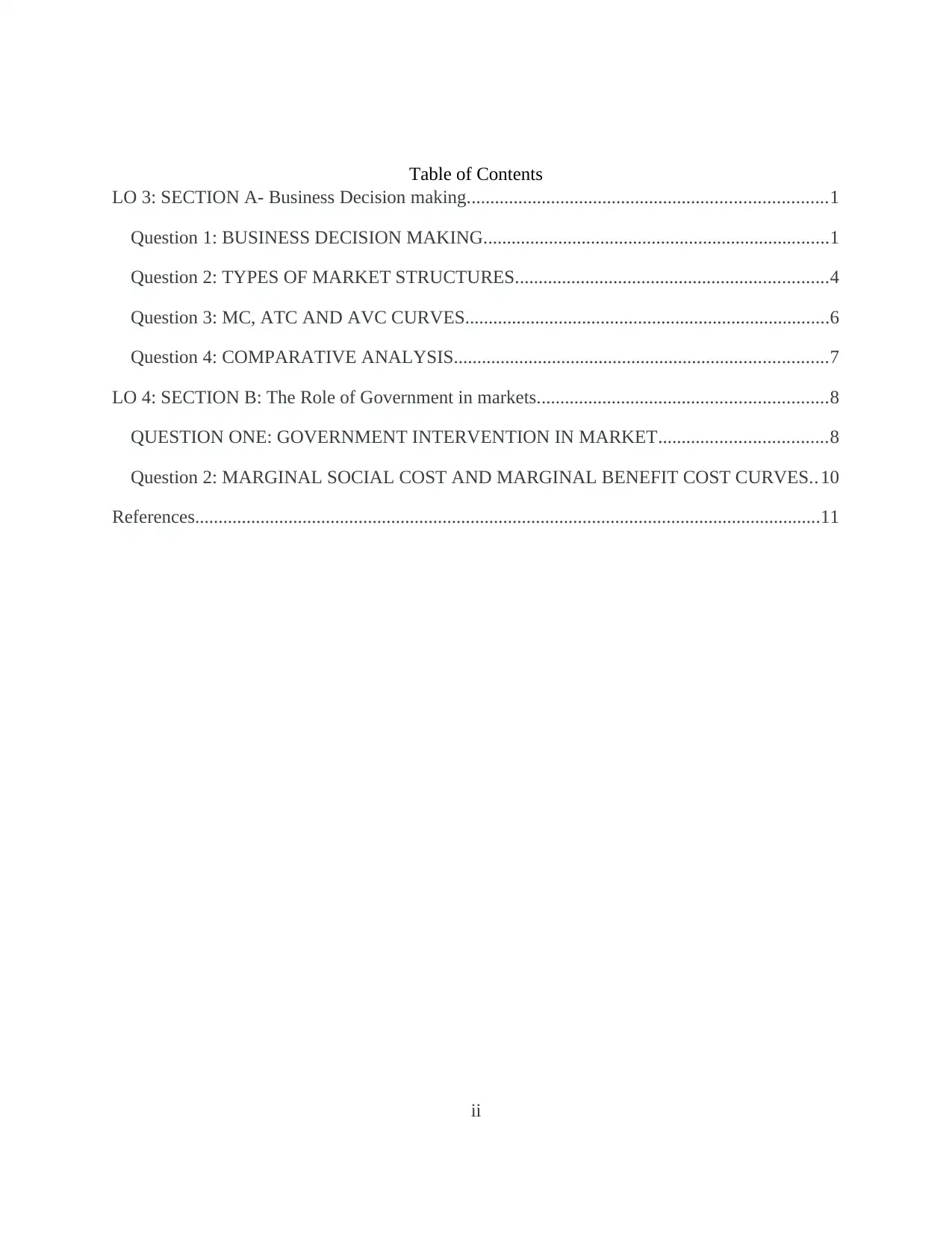
Table of Contents
LO 3: SECTION A- Business Decision making.............................................................................1
Question 1: BUSINESS DECISION MAKING..........................................................................1
Question 2: TYPES OF MARKET STRUCTURES...................................................................4
Question 3: MC, ATC AND AVC CURVES..............................................................................6
Question 4: COMPARATIVE ANALYSIS................................................................................7
LO 4: SECTION B: The Role of Government in markets..............................................................8
QUESTION ONE: GOVERNMENT INTERVENTION IN MARKET....................................8
Question 2: MARGINAL SOCIAL COST AND MARGINAL BENEFIT COST CURVES..10
References......................................................................................................................................11
ii
LO 3: SECTION A- Business Decision making.............................................................................1
Question 1: BUSINESS DECISION MAKING..........................................................................1
Question 2: TYPES OF MARKET STRUCTURES...................................................................4
Question 3: MC, ATC AND AVC CURVES..............................................................................6
Question 4: COMPARATIVE ANALYSIS................................................................................7
LO 4: SECTION B: The Role of Government in markets..............................................................8
QUESTION ONE: GOVERNMENT INTERVENTION IN MARKET....................................8
Question 2: MARGINAL SOCIAL COST AND MARGINAL BENEFIT COST CURVES..10
References......................................................................................................................................11
ii
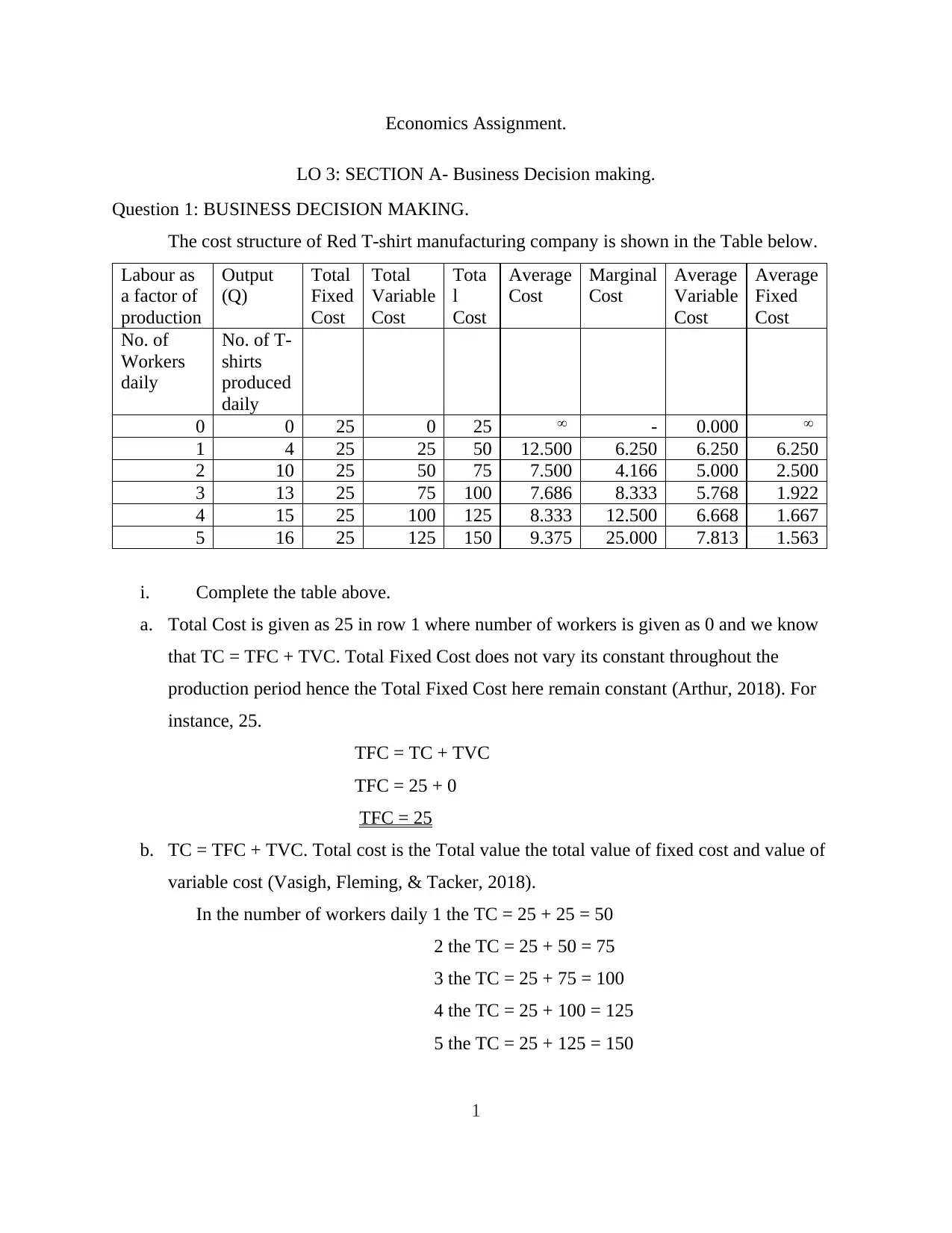
Economics Assignment.
LO 3: SECTION A- Business Decision making.
Question 1: BUSINESS DECISION MAKING.
The cost structure of Red T-shirt manufacturing company is shown in the Table below.
Labour as
a factor of
production
Output
(Q)
Total
Fixed
Cost
Total
Variable
Cost
Tota
l
Cost
Average
Cost
Marginal
Cost
Average
Variable
Cost
Average
Fixed
Cost
No. of
Workers
daily
No. of T-
shirts
produced
daily
0 0 25 0 25 ∞ - 0.000 ∞
1 4 25 25 50 12.500 6.250 6.250 6.250
2 10 25 50 75 7.500 4.166 5.000 2.500
3 13 25 75 100 7.686 8.333 5.768 1.922
4 15 25 100 125 8.333 12.500 6.668 1.667
5 16 25 125 150 9.375 25.000 7.813 1.563
i. Complete the table above.
a. Total Cost is given as 25 in row 1 where number of workers is given as 0 and we know
that TC = TFC + TVC. Total Fixed Cost does not vary its constant throughout the
production period hence the Total Fixed Cost here remain constant (Arthur, 2018). For
instance, 25.
TFC = TC + TVC
TFC = 25 + 0
TFC = 25
b. TC = TFC + TVC. Total cost is the Total value the total value of fixed cost and value of
variable cost (Vasigh, Fleming, & Tacker, 2018).
In the number of workers daily 1 the TC = 25 + 25 = 50
2 the TC = 25 + 50 = 75
3 the TC = 25 + 75 = 100
4 the TC = 25 + 100 = 125
5 the TC = 25 + 125 = 150
1
LO 3: SECTION A- Business Decision making.
Question 1: BUSINESS DECISION MAKING.
The cost structure of Red T-shirt manufacturing company is shown in the Table below.
Labour as
a factor of
production
Output
(Q)
Total
Fixed
Cost
Total
Variable
Cost
Tota
l
Cost
Average
Cost
Marginal
Cost
Average
Variable
Cost
Average
Fixed
Cost
No. of
Workers
daily
No. of T-
shirts
produced
daily
0 0 25 0 25 ∞ - 0.000 ∞
1 4 25 25 50 12.500 6.250 6.250 6.250
2 10 25 50 75 7.500 4.166 5.000 2.500
3 13 25 75 100 7.686 8.333 5.768 1.922
4 15 25 100 125 8.333 12.500 6.668 1.667
5 16 25 125 150 9.375 25.000 7.813 1.563
i. Complete the table above.
a. Total Cost is given as 25 in row 1 where number of workers is given as 0 and we know
that TC = TFC + TVC. Total Fixed Cost does not vary its constant throughout the
production period hence the Total Fixed Cost here remain constant (Arthur, 2018). For
instance, 25.
TFC = TC + TVC
TFC = 25 + 0
TFC = 25
b. TC = TFC + TVC. Total cost is the Total value the total value of fixed cost and value of
variable cost (Vasigh, Fleming, & Tacker, 2018).
In the number of workers daily 1 the TC = 25 + 25 = 50
2 the TC = 25 + 50 = 75
3 the TC = 25 + 75 = 100
4 the TC = 25 + 100 = 125
5 the TC = 25 + 125 = 150
1
⊘ This is a preview!⊘
Do you want full access?
Subscribe today to unlock all pages.

Trusted by 1+ million students worldwide
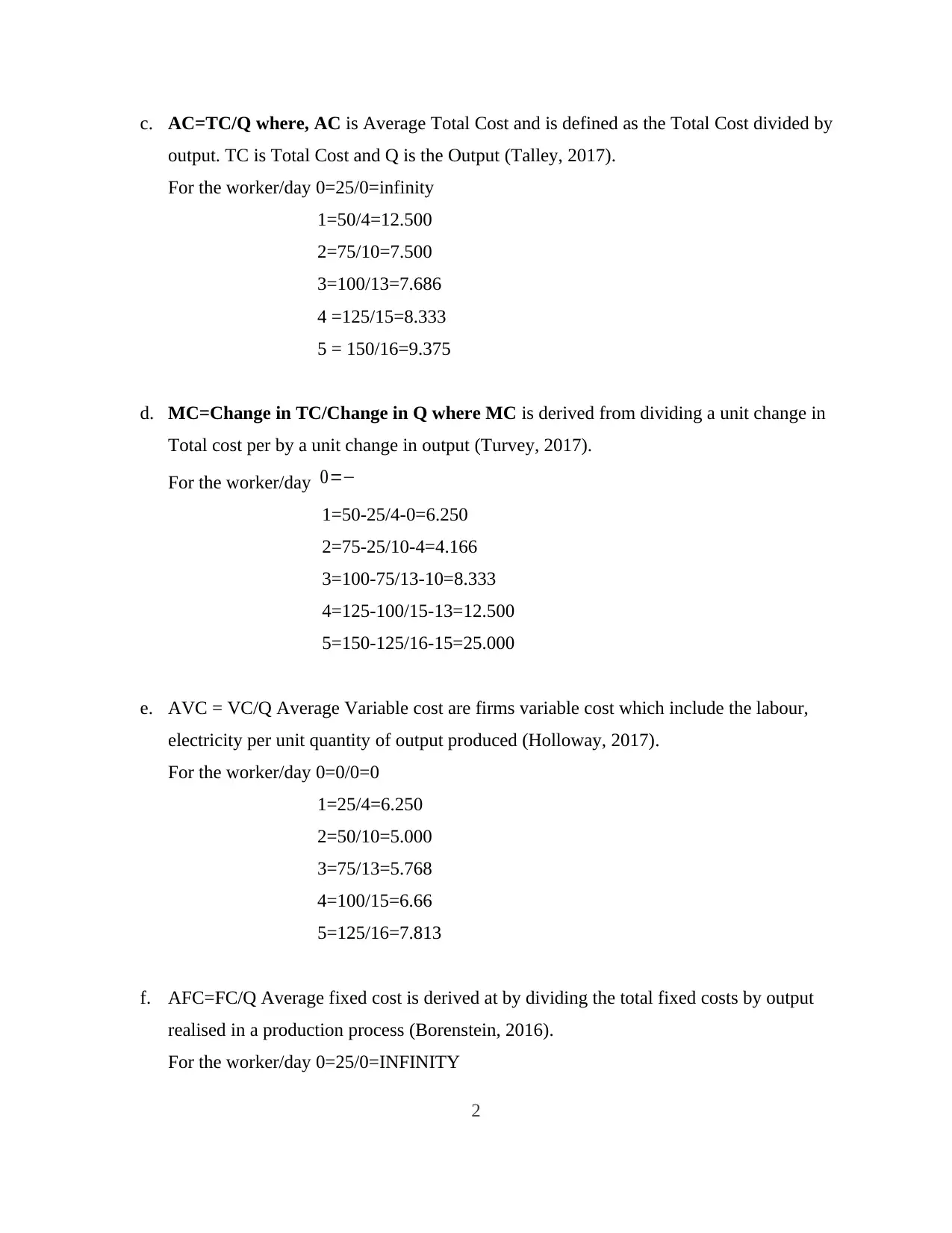
c. AC=TC/Q where, AC is Average Total Cost and is defined as the Total Cost divided by
output. TC is Total Cost and Q is the Output (Talley, 2017).
For the worker/day 0=25/0=infinity
1=50/4=12.500
2=75/10=7.500
3=100/13=7.686
4 =125/15=8.333
5 = 150/16=9.375
d. MC=Change in TC/Change in Q where MC is derived from dividing a unit change in
Total cost per by a unit change in output (Turvey, 2017).
For the worker/day 0=−
1=50-25/4-0=6.250
2=75-25/10-4=4.166
3=100-75/13-10=8.333
4=125-100/15-13=12.500
5=150-125/16-15=25.000
e. AVC = VC/Q Average Variable cost are firms variable cost which include the labour,
electricity per unit quantity of output produced (Holloway, 2017).
For the worker/day 0=0/0=0
1=25/4=6.250
2=50/10=5.000
3=75/13=5.768
4=100/15=6.66
5=125/16=7.813
f. AFC=FC/Q Average fixed cost is derived at by dividing the total fixed costs by output
realised in a production process (Borenstein, 2016).
For the worker/day 0=25/0=INFINITY
2
output. TC is Total Cost and Q is the Output (Talley, 2017).
For the worker/day 0=25/0=infinity
1=50/4=12.500
2=75/10=7.500
3=100/13=7.686
4 =125/15=8.333
5 = 150/16=9.375
d. MC=Change in TC/Change in Q where MC is derived from dividing a unit change in
Total cost per by a unit change in output (Turvey, 2017).
For the worker/day 0=−
1=50-25/4-0=6.250
2=75-25/10-4=4.166
3=100-75/13-10=8.333
4=125-100/15-13=12.500
5=150-125/16-15=25.000
e. AVC = VC/Q Average Variable cost are firms variable cost which include the labour,
electricity per unit quantity of output produced (Holloway, 2017).
For the worker/day 0=0/0=0
1=25/4=6.250
2=50/10=5.000
3=75/13=5.768
4=100/15=6.66
5=125/16=7.813
f. AFC=FC/Q Average fixed cost is derived at by dividing the total fixed costs by output
realised in a production process (Borenstein, 2016).
For the worker/day 0=25/0=INFINITY
2
Paraphrase This Document
Need a fresh take? Get an instant paraphrase of this document with our AI Paraphraser
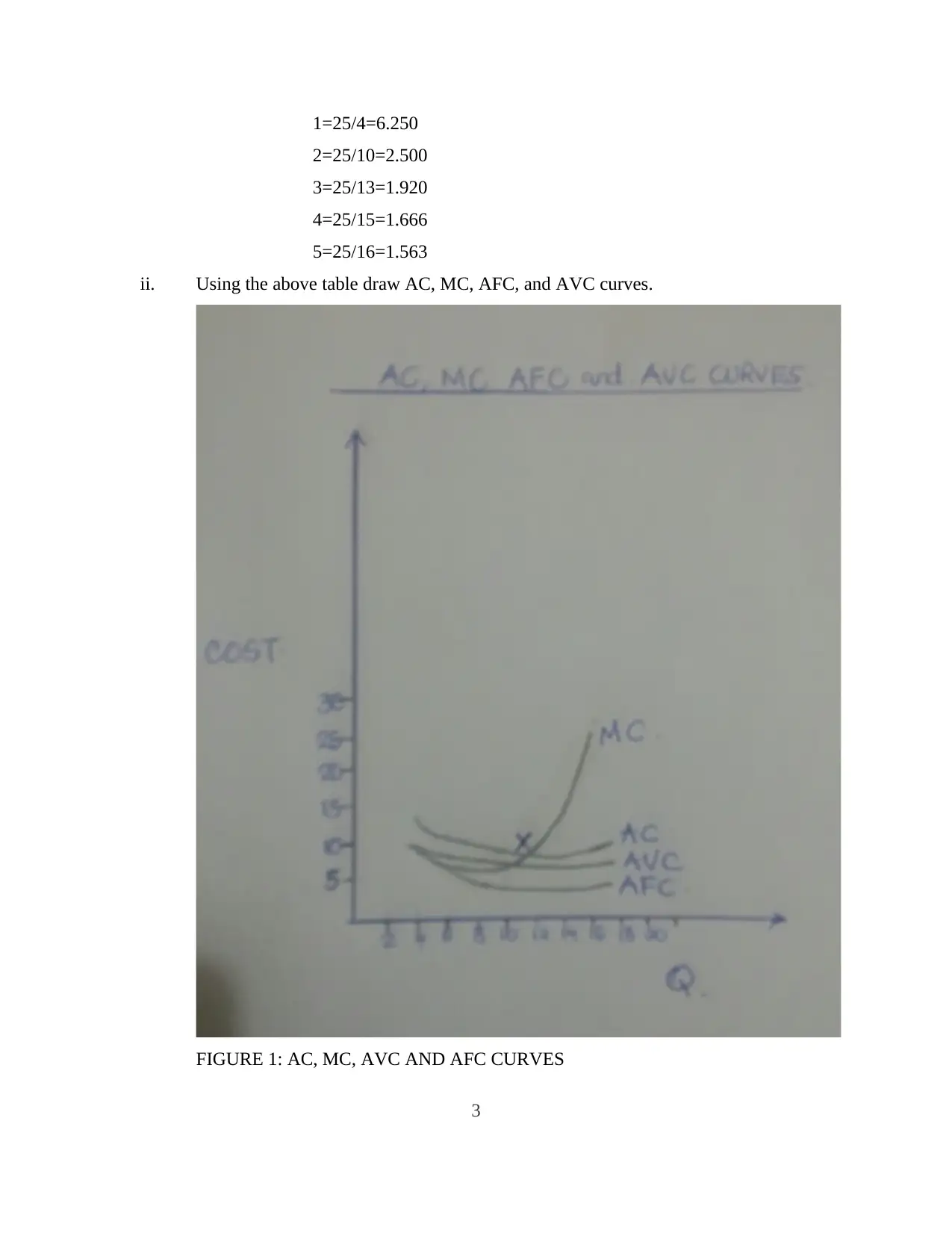
1=25/4=6.250
2=25/10=2.500
3=25/13=1.920
4=25/15=1.666
5=25/16=1.563
ii. Using the above table draw AC, MC, AFC, and AVC curves.
FIGURE 1: AC, MC, AVC AND AFC CURVES
3
2=25/10=2.500
3=25/13=1.920
4=25/15=1.666
5=25/16=1.563
ii. Using the above table draw AC, MC, AFC, and AVC curves.
FIGURE 1: AC, MC, AVC AND AFC CURVES
3
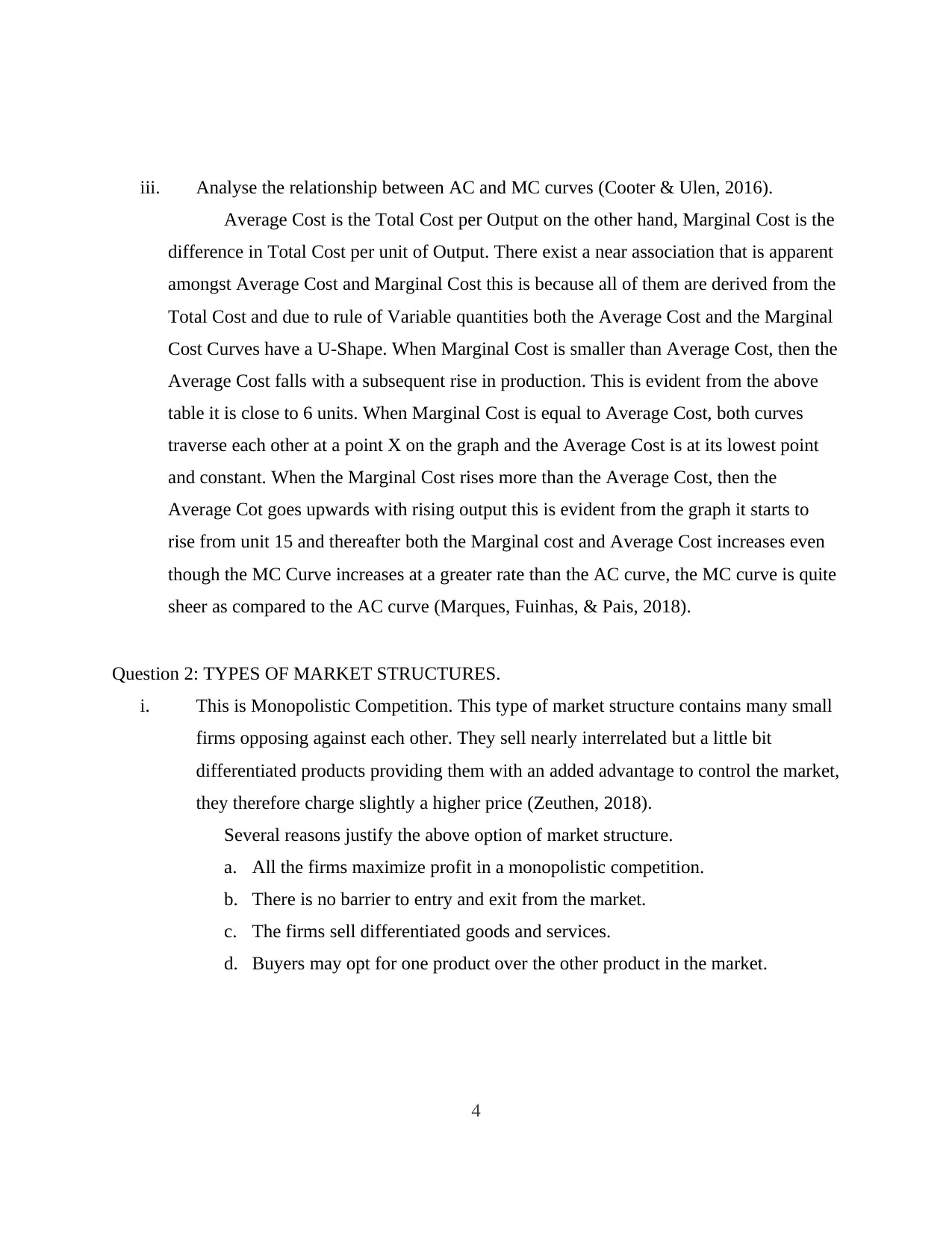
iii. Analyse the relationship between AC and MC curves (Cooter & Ulen, 2016).
Average Cost is the Total Cost per Output on the other hand, Marginal Cost is the
difference in Total Cost per unit of Output. There exist a near association that is apparent
amongst Average Cost and Marginal Cost this is because all of them are derived from the
Total Cost and due to rule of Variable quantities both the Average Cost and the Marginal
Cost Curves have a U-Shape. When Marginal Cost is smaller than Average Cost, then the
Average Cost falls with a subsequent rise in production. This is evident from the above
table it is close to 6 units. When Marginal Cost is equal to Average Cost, both curves
traverse each other at a point X on the graph and the Average Cost is at its lowest point
and constant. When the Marginal Cost rises more than the Average Cost, then the
Average Cot goes upwards with rising output this is evident from the graph it starts to
rise from unit 15 and thereafter both the Marginal cost and Average Cost increases even
though the MC Curve increases at a greater rate than the AC curve, the MC curve is quite
sheer as compared to the AC curve (Marques, Fuinhas, & Pais, 2018).
Question 2: TYPES OF MARKET STRUCTURES.
i. This is Monopolistic Competition. This type of market structure contains many small
firms opposing against each other. They sell nearly interrelated but a little bit
differentiated products providing them with an added advantage to control the market,
they therefore charge slightly a higher price (Zeuthen, 2018).
Several reasons justify the above option of market structure.
a. All the firms maximize profit in a monopolistic competition.
b. There is no barrier to entry and exit from the market.
c. The firms sell differentiated goods and services.
d. Buyers may opt for one product over the other product in the market.
4
Average Cost is the Total Cost per Output on the other hand, Marginal Cost is the
difference in Total Cost per unit of Output. There exist a near association that is apparent
amongst Average Cost and Marginal Cost this is because all of them are derived from the
Total Cost and due to rule of Variable quantities both the Average Cost and the Marginal
Cost Curves have a U-Shape. When Marginal Cost is smaller than Average Cost, then the
Average Cost falls with a subsequent rise in production. This is evident from the above
table it is close to 6 units. When Marginal Cost is equal to Average Cost, both curves
traverse each other at a point X on the graph and the Average Cost is at its lowest point
and constant. When the Marginal Cost rises more than the Average Cost, then the
Average Cot goes upwards with rising output this is evident from the graph it starts to
rise from unit 15 and thereafter both the Marginal cost and Average Cost increases even
though the MC Curve increases at a greater rate than the AC curve, the MC curve is quite
sheer as compared to the AC curve (Marques, Fuinhas, & Pais, 2018).
Question 2: TYPES OF MARKET STRUCTURES.
i. This is Monopolistic Competition. This type of market structure contains many small
firms opposing against each other. They sell nearly interrelated but a little bit
differentiated products providing them with an added advantage to control the market,
they therefore charge slightly a higher price (Zeuthen, 2018).
Several reasons justify the above option of market structure.
a. All the firms maximize profit in a monopolistic competition.
b. There is no barrier to entry and exit from the market.
c. The firms sell differentiated goods and services.
d. Buyers may opt for one product over the other product in the market.
4
⊘ This is a preview!⊘
Do you want full access?
Subscribe today to unlock all pages.

Trusted by 1+ million students worldwide
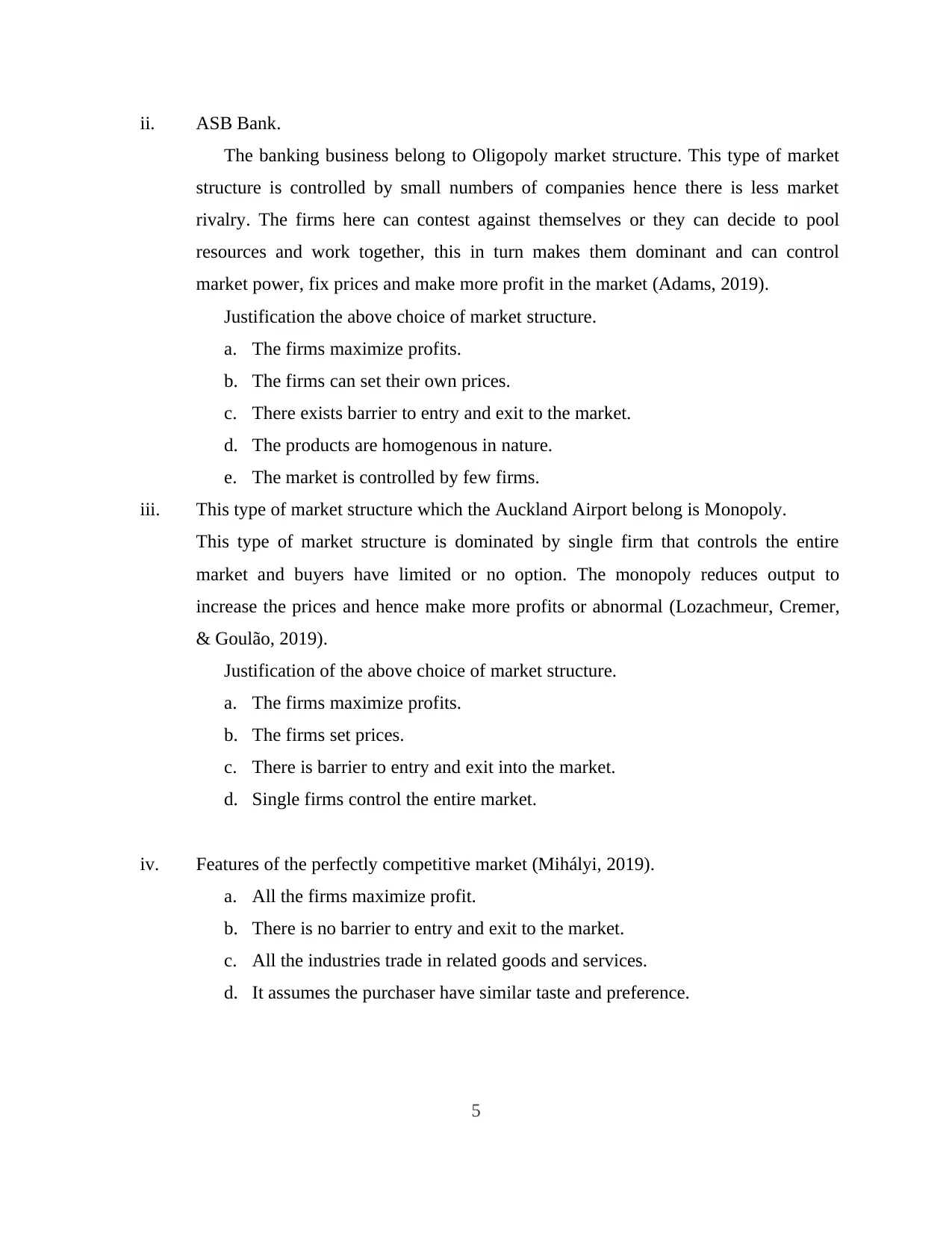
ii. ASB Bank.
The banking business belong to Oligopoly market structure. This type of market
structure is controlled by small numbers of companies hence there is less market
rivalry. The firms here can contest against themselves or they can decide to pool
resources and work together, this in turn makes them dominant and can control
market power, fix prices and make more profit in the market (Adams, 2019).
Justification the above choice of market structure.
a. The firms maximize profits.
b. The firms can set their own prices.
c. There exists barrier to entry and exit to the market.
d. The products are homogenous in nature.
e. The market is controlled by few firms.
iii. This type of market structure which the Auckland Airport belong is Monopoly.
This type of market structure is dominated by single firm that controls the entire
market and buyers have limited or no option. The monopoly reduces output to
increase the prices and hence make more profits or abnormal (Lozachmeur, Cremer,
& Goulão, 2019).
Justification of the above choice of market structure.
a. The firms maximize profits.
b. The firms set prices.
c. There is barrier to entry and exit into the market.
d. Single firms control the entire market.
iv. Features of the perfectly competitive market (Mihályi, 2019).
a. All the firms maximize profit.
b. There is no barrier to entry and exit to the market.
c. All the industries trade in related goods and services.
d. It assumes the purchaser have similar taste and preference.
5
The banking business belong to Oligopoly market structure. This type of market
structure is controlled by small numbers of companies hence there is less market
rivalry. The firms here can contest against themselves or they can decide to pool
resources and work together, this in turn makes them dominant and can control
market power, fix prices and make more profit in the market (Adams, 2019).
Justification the above choice of market structure.
a. The firms maximize profits.
b. The firms can set their own prices.
c. There exists barrier to entry and exit to the market.
d. The products are homogenous in nature.
e. The market is controlled by few firms.
iii. This type of market structure which the Auckland Airport belong is Monopoly.
This type of market structure is dominated by single firm that controls the entire
market and buyers have limited or no option. The monopoly reduces output to
increase the prices and hence make more profits or abnormal (Lozachmeur, Cremer,
& Goulão, 2019).
Justification of the above choice of market structure.
a. The firms maximize profits.
b. The firms set prices.
c. There is barrier to entry and exit into the market.
d. Single firms control the entire market.
iv. Features of the perfectly competitive market (Mihályi, 2019).
a. All the firms maximize profit.
b. There is no barrier to entry and exit to the market.
c. All the industries trade in related goods and services.
d. It assumes the purchaser have similar taste and preference.
5
Paraphrase This Document
Need a fresh take? Get an instant paraphrase of this document with our AI Paraphraser
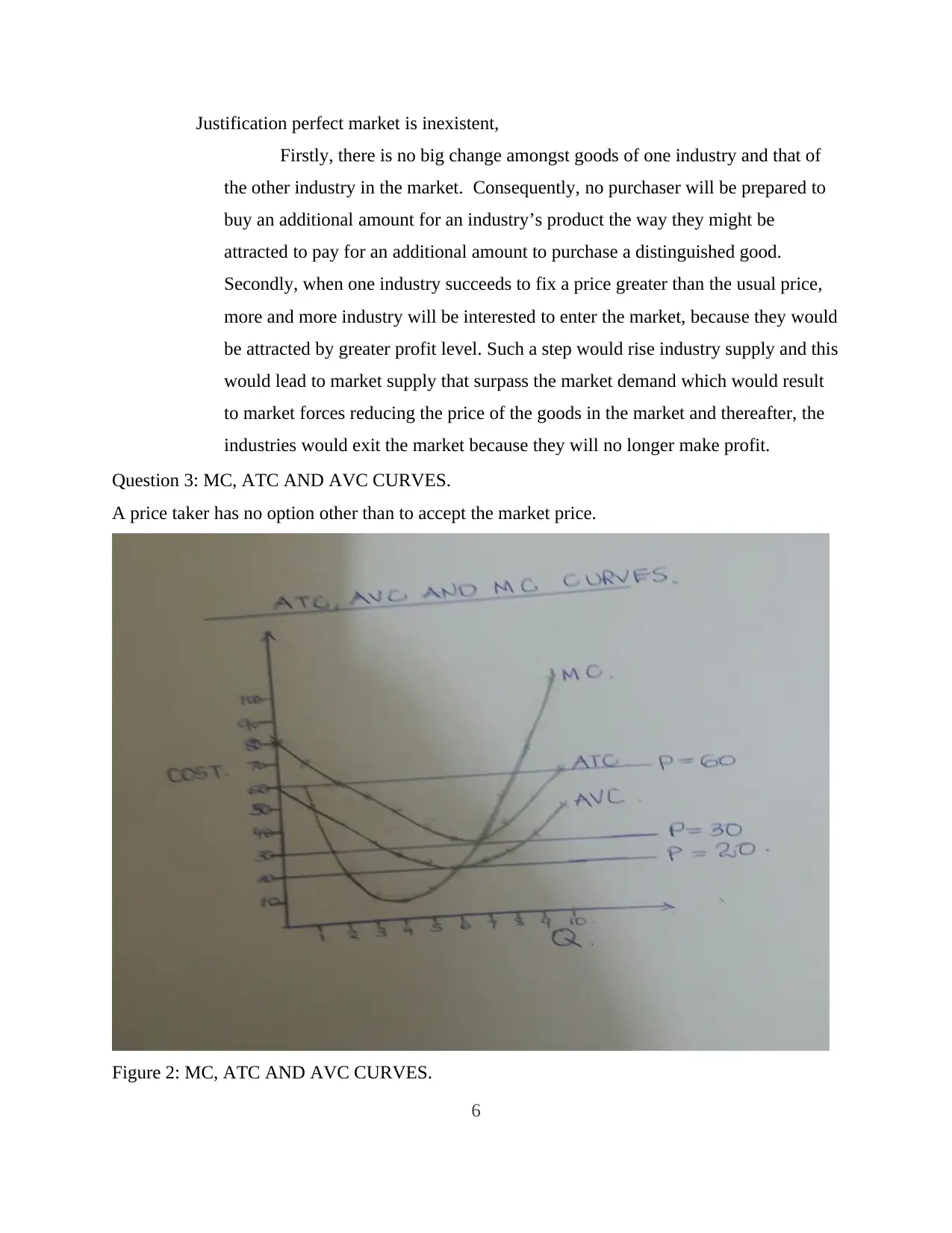
Justification perfect market is inexistent,
Firstly, there is no big change amongst goods of one industry and that of
the other industry in the market. Consequently, no purchaser will be prepared to
buy an additional amount for an industry’s product the way they might be
attracted to pay for an additional amount to purchase a distinguished good.
Secondly, when one industry succeeds to fix a price greater than the usual price,
more and more industry will be interested to enter the market, because they would
be attracted by greater profit level. Such a step would rise industry supply and this
would lead to market supply that surpass the market demand which would result
to market forces reducing the price of the goods in the market and thereafter, the
industries would exit the market because they will no longer make profit.
Question 3: MC, ATC AND AVC CURVES.
A price taker has no option other than to accept the market price.
Figure 2: MC, ATC AND AVC CURVES.
6
Firstly, there is no big change amongst goods of one industry and that of
the other industry in the market. Consequently, no purchaser will be prepared to
buy an additional amount for an industry’s product the way they might be
attracted to pay for an additional amount to purchase a distinguished good.
Secondly, when one industry succeeds to fix a price greater than the usual price,
more and more industry will be interested to enter the market, because they would
be attracted by greater profit level. Such a step would rise industry supply and this
would lead to market supply that surpass the market demand which would result
to market forces reducing the price of the goods in the market and thereafter, the
industries would exit the market because they will no longer make profit.
Question 3: MC, ATC AND AVC CURVES.
A price taker has no option other than to accept the market price.
Figure 2: MC, ATC AND AVC CURVES.
6
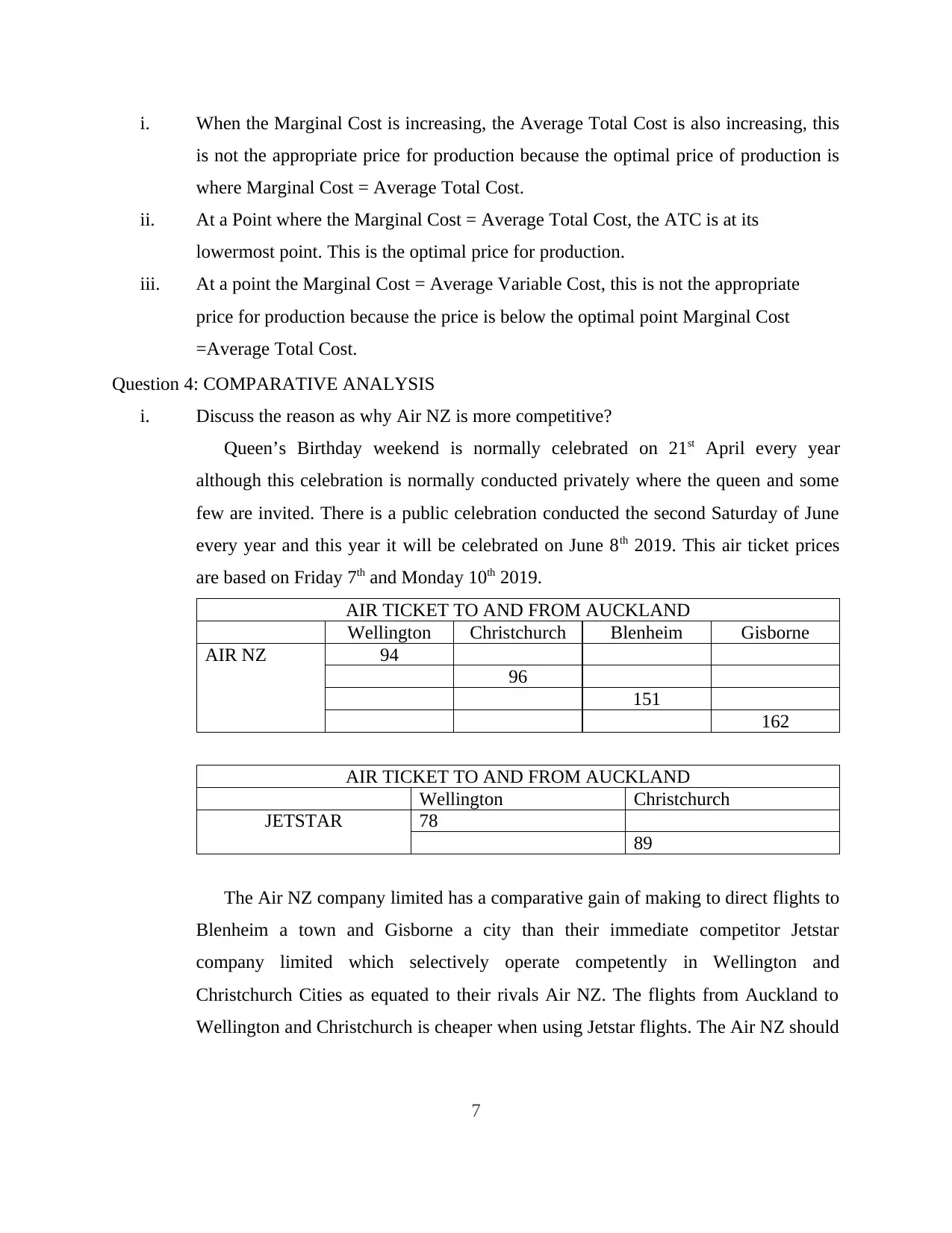
i. When the Marginal Cost is increasing, the Average Total Cost is also increasing, this
is not the appropriate price for production because the optimal price of production is
where Marginal Cost = Average Total Cost.
ii. At a Point where the Marginal Cost = Average Total Cost, the ATC is at its
lowermost point. This is the optimal price for production.
iii. At a point the Marginal Cost = Average Variable Cost, this is not the appropriate
price for production because the price is below the optimal point Marginal Cost
=Average Total Cost.
Question 4: COMPARATIVE ANALYSIS
i. Discuss the reason as why Air NZ is more competitive?
Queen’s Birthday weekend is normally celebrated on 21st April every year
although this celebration is normally conducted privately where the queen and some
few are invited. There is a public celebration conducted the second Saturday of June
every year and this year it will be celebrated on June 8th 2019. This air ticket prices
are based on Friday 7th and Monday 10th 2019.
AIR TICKET TO AND FROM AUCKLAND
Wellington Christchurch Blenheim Gisborne
AIR NZ 94
96
151
162
AIR TICKET TO AND FROM AUCKLAND
Wellington Christchurch
JETSTAR 78
89
The Air NZ company limited has a comparative gain of making to direct flights to
Blenheim a town and Gisborne a city than their immediate competitor Jetstar
company limited which selectively operate competently in Wellington and
Christchurch Cities as equated to their rivals Air NZ. The flights from Auckland to
Wellington and Christchurch is cheaper when using Jetstar flights. The Air NZ should
7
is not the appropriate price for production because the optimal price of production is
where Marginal Cost = Average Total Cost.
ii. At a Point where the Marginal Cost = Average Total Cost, the ATC is at its
lowermost point. This is the optimal price for production.
iii. At a point the Marginal Cost = Average Variable Cost, this is not the appropriate
price for production because the price is below the optimal point Marginal Cost
=Average Total Cost.
Question 4: COMPARATIVE ANALYSIS
i. Discuss the reason as why Air NZ is more competitive?
Queen’s Birthday weekend is normally celebrated on 21st April every year
although this celebration is normally conducted privately where the queen and some
few are invited. There is a public celebration conducted the second Saturday of June
every year and this year it will be celebrated on June 8th 2019. This air ticket prices
are based on Friday 7th and Monday 10th 2019.
AIR TICKET TO AND FROM AUCKLAND
Wellington Christchurch Blenheim Gisborne
AIR NZ 94
96
151
162
AIR TICKET TO AND FROM AUCKLAND
Wellington Christchurch
JETSTAR 78
89
The Air NZ company limited has a comparative gain of making to direct flights to
Blenheim a town and Gisborne a city than their immediate competitor Jetstar
company limited which selectively operate competently in Wellington and
Christchurch Cities as equated to their rivals Air NZ. The flights from Auckland to
Wellington and Christchurch is cheaper when using Jetstar flights. The Air NZ should
7
⊘ This is a preview!⊘
Do you want full access?
Subscribe today to unlock all pages.

Trusted by 1+ million students worldwide
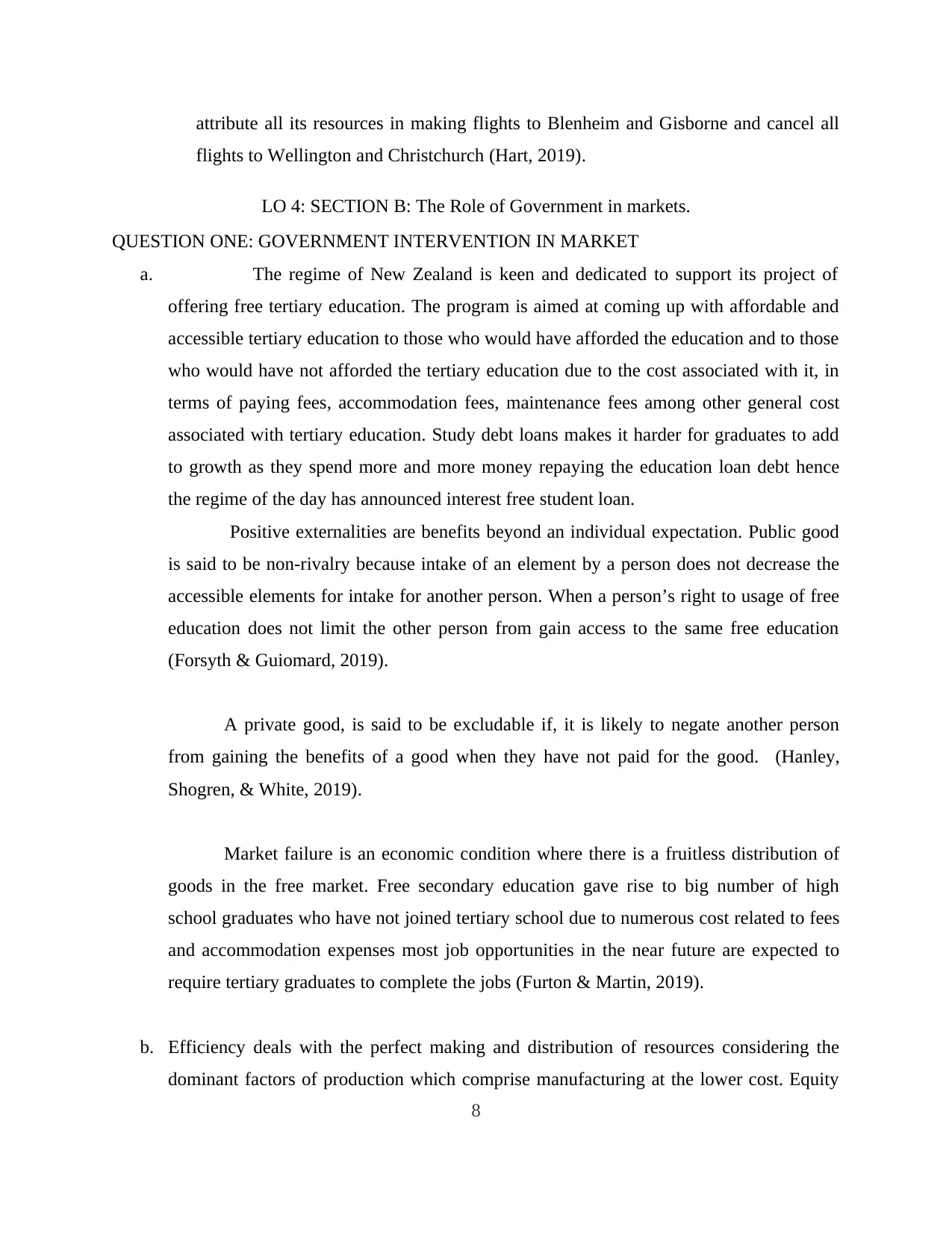
attribute all its resources in making flights to Blenheim and Gisborne and cancel all
flights to Wellington and Christchurch (Hart, 2019).
LO 4: SECTION B: The Role of Government in markets.
QUESTION ONE: GOVERNMENT INTERVENTION IN MARKET
a. The regime of New Zealand is keen and dedicated to support its project of
offering free tertiary education. The program is aimed at coming up with affordable and
accessible tertiary education to those who would have afforded the education and to those
who would have not afforded the tertiary education due to the cost associated with it, in
terms of paying fees, accommodation fees, maintenance fees among other general cost
associated with tertiary education. Study debt loans makes it harder for graduates to add
to growth as they spend more and more money repaying the education loan debt hence
the regime of the day has announced interest free student loan.
Positive externalities are benefits beyond an individual expectation. Public good
is said to be non-rivalry because intake of an element by a person does not decrease the
accessible elements for intake for another person. When a person’s right to usage of free
education does not limit the other person from gain access to the same free education
(Forsyth & Guiomard, 2019).
A private good, is said to be excludable if, it is likely to negate another person
from gaining the benefits of a good when they have not paid for the good. (Hanley,
Shogren, & White, 2019).
Market failure is an economic condition where there is a fruitless distribution of
goods in the free market. Free secondary education gave rise to big number of high
school graduates who have not joined tertiary school due to numerous cost related to fees
and accommodation expenses most job opportunities in the near future are expected to
require tertiary graduates to complete the jobs (Furton & Martin, 2019).
b. Efficiency deals with the perfect making and distribution of resources considering the
dominant factors of production which comprise manufacturing at the lower cost. Equity
8
flights to Wellington and Christchurch (Hart, 2019).
LO 4: SECTION B: The Role of Government in markets.
QUESTION ONE: GOVERNMENT INTERVENTION IN MARKET
a. The regime of New Zealand is keen and dedicated to support its project of
offering free tertiary education. The program is aimed at coming up with affordable and
accessible tertiary education to those who would have afforded the education and to those
who would have not afforded the tertiary education due to the cost associated with it, in
terms of paying fees, accommodation fees, maintenance fees among other general cost
associated with tertiary education. Study debt loans makes it harder for graduates to add
to growth as they spend more and more money repaying the education loan debt hence
the regime of the day has announced interest free student loan.
Positive externalities are benefits beyond an individual expectation. Public good
is said to be non-rivalry because intake of an element by a person does not decrease the
accessible elements for intake for another person. When a person’s right to usage of free
education does not limit the other person from gain access to the same free education
(Forsyth & Guiomard, 2019).
A private good, is said to be excludable if, it is likely to negate another person
from gaining the benefits of a good when they have not paid for the good. (Hanley,
Shogren, & White, 2019).
Market failure is an economic condition where there is a fruitless distribution of
goods in the free market. Free secondary education gave rise to big number of high
school graduates who have not joined tertiary school due to numerous cost related to fees
and accommodation expenses most job opportunities in the near future are expected to
require tertiary graduates to complete the jobs (Furton & Martin, 2019).
b. Efficiency deals with the perfect making and distribution of resources considering the
dominant factors of production which comprise manufacturing at the lower cost. Equity
8
Paraphrase This Document
Need a fresh take? Get an instant paraphrase of this document with our AI Paraphraser
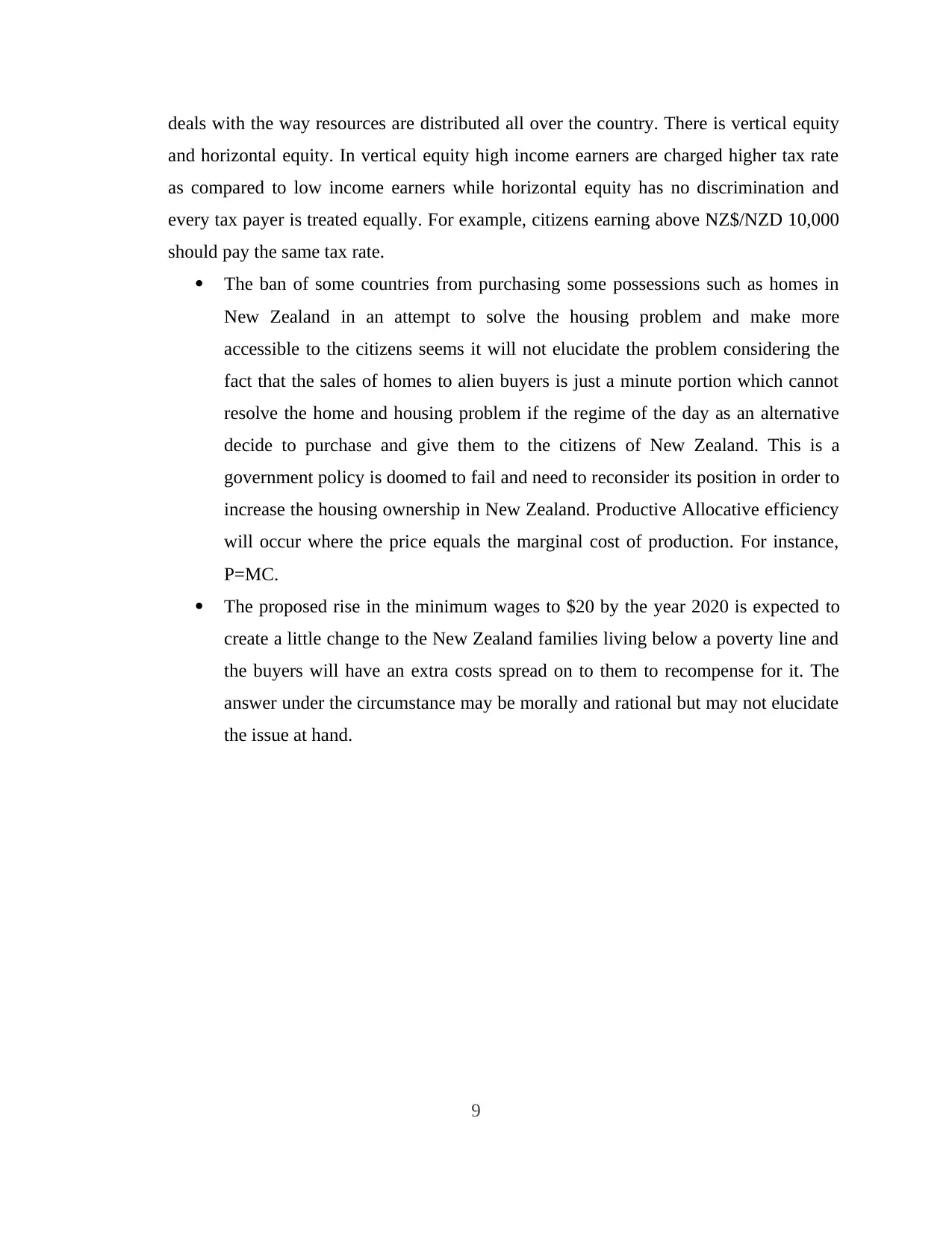
deals with the way resources are distributed all over the country. There is vertical equity
and horizontal equity. In vertical equity high income earners are charged higher tax rate
as compared to low income earners while horizontal equity has no discrimination and
every tax payer is treated equally. For example, citizens earning above NZ$/NZD 10,000
should pay the same tax rate.
The ban of some countries from purchasing some possessions such as homes in
New Zealand in an attempt to solve the housing problem and make more
accessible to the citizens seems it will not elucidate the problem considering the
fact that the sales of homes to alien buyers is just a minute portion which cannot
resolve the home and housing problem if the regime of the day as an alternative
decide to purchase and give them to the citizens of New Zealand. This is a
government policy is doomed to fail and need to reconsider its position in order to
increase the housing ownership in New Zealand. Productive Allocative efficiency
will occur where the price equals the marginal cost of production. For instance,
P=MC.
The proposed rise in the minimum wages to $20 by the year 2020 is expected to
create a little change to the New Zealand families living below a poverty line and
the buyers will have an extra costs spread on to them to recompense for it. The
answer under the circumstance may be morally and rational but may not elucidate
the issue at hand.
9
and horizontal equity. In vertical equity high income earners are charged higher tax rate
as compared to low income earners while horizontal equity has no discrimination and
every tax payer is treated equally. For example, citizens earning above NZ$/NZD 10,000
should pay the same tax rate.
The ban of some countries from purchasing some possessions such as homes in
New Zealand in an attempt to solve the housing problem and make more
accessible to the citizens seems it will not elucidate the problem considering the
fact that the sales of homes to alien buyers is just a minute portion which cannot
resolve the home and housing problem if the regime of the day as an alternative
decide to purchase and give them to the citizens of New Zealand. This is a
government policy is doomed to fail and need to reconsider its position in order to
increase the housing ownership in New Zealand. Productive Allocative efficiency
will occur where the price equals the marginal cost of production. For instance,
P=MC.
The proposed rise in the minimum wages to $20 by the year 2020 is expected to
create a little change to the New Zealand families living below a poverty line and
the buyers will have an extra costs spread on to them to recompense for it. The
answer under the circumstance may be morally and rational but may not elucidate
the issue at hand.
9
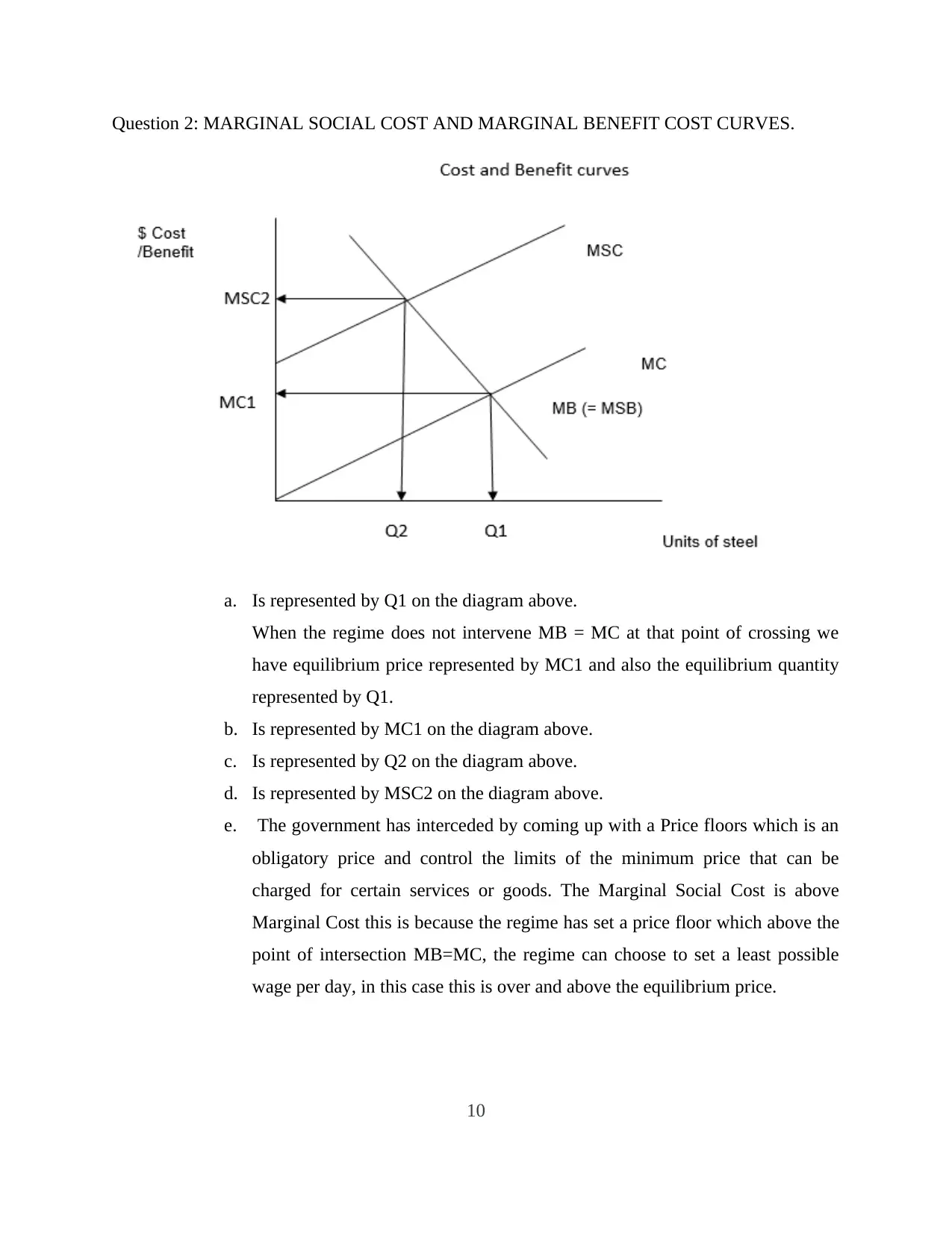
Question 2: MARGINAL SOCIAL COST AND MARGINAL BENEFIT COST CURVES.
a. Is represented by Q1 on the diagram above.
When the regime does not intervene MB = MC at that point of crossing we
have equilibrium price represented by MC1 and also the equilibrium quantity
represented by Q1.
b. Is represented by MC1 on the diagram above.
c. Is represented by Q2 on the diagram above.
d. Is represented by MSC2 on the diagram above.
e. The government has interceded by coming up with a Price floors which is an
obligatory price and control the limits of the minimum price that can be
charged for certain services or goods. The Marginal Social Cost is above
Marginal Cost this is because the regime has set a price floor which above the
point of intersection MB=MC, the regime can choose to set a least possible
wage per day, in this case this is over and above the equilibrium price.
10
a. Is represented by Q1 on the diagram above.
When the regime does not intervene MB = MC at that point of crossing we
have equilibrium price represented by MC1 and also the equilibrium quantity
represented by Q1.
b. Is represented by MC1 on the diagram above.
c. Is represented by Q2 on the diagram above.
d. Is represented by MSC2 on the diagram above.
e. The government has interceded by coming up with a Price floors which is an
obligatory price and control the limits of the minimum price that can be
charged for certain services or goods. The Marginal Social Cost is above
Marginal Cost this is because the regime has set a price floor which above the
point of intersection MB=MC, the regime can choose to set a least possible
wage per day, in this case this is over and above the equilibrium price.
10
⊘ This is a preview!⊘
Do you want full access?
Subscribe today to unlock all pages.

Trusted by 1+ million students worldwide
1 out of 13
Related Documents
Your All-in-One AI-Powered Toolkit for Academic Success.
+13062052269
info@desklib.com
Available 24*7 on WhatsApp / Email
![[object Object]](/_next/static/media/star-bottom.7253800d.svg)
Unlock your academic potential
Copyright © 2020–2025 A2Z Services. All Rights Reserved. Developed and managed by ZUCOL.




